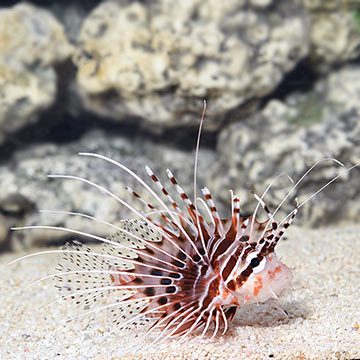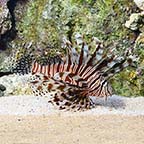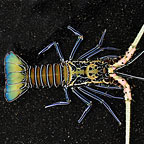Antennata Lionfish
(Pterois antennata)

Please Note: Due to variations within species, your item may not look identical to the image provided. Approximate size range may also vary between individual specimen.
Please Note: Due to variations within species, your item may not look identical to the image provided. Approximate size range may also vary between individual specimen.
Antennata Lionfish
(Pterois antennata)
Additional locales and sizes may be available!
Additional locales and sizes may be available! Email me when available|
Product Notes:
· We cannot ship this product to Florida. |
Quick Stats
Care Level
Moderate
Temperament
Semi-aggressive
Color Form
Black, Red, White
Diet
Carnivore
Reef Compatible
With Caution
Water Conditions
sg 1.020-1.025, 72-78° F, dKH 8-12, pH 8.1-8.4
Max. Size
1' 3"
Venomous
Yes
Family
Scorpaenidae
Minimum Tank Size
120 gallons
Compatibility
View Chart
What do these Quick Stats mean? Click here for more information
Care Level
Moderate
Temperament
Semi-aggressive
Color Form
Black, Red, White
Diet
Carnivore
Reef Compatible
With Caution
Water Conditions
sg 1.020-1.025, 72-78° F, dKH 8-12, pH 8.1-8.4
Max. Size
1' 3"
Venomous
Yes
Family
Scorpaenidae
Minimum Tank Size
120 gallons
Compatibility
View Chart
What do these Quick Stats mean? Click here for more information
Overview
The Antennata Lionfish, also known as the Ragged-finned Firefish or Spotfin Lionfish, has red, white, and black vertical stripes along the body. Its most striking feature is its large, fan-like pectoral fins and tall, quill-like dorsal fins, lacking connective tissue, giving them a spiny look.
A 50 gallon or larger aquarium with numerous hiding places is suitable. It will hide while acclimating to its new environment and should be provided with a good supply of ghost shrimp. The spines on the dorsal, pelvic, and anal fins are venomous, causing reactions similar to a bee sting, only stronger.
When first introduced into the aquarium, live saltwater feeder shrimp should be used to entice this fish to eat. After acclimating the diet should consist of meaty foods such as live shrimp (including ornamental shrimp), live fish, and sometimes, crustacean flesh.
Approximate Purchase Size: Small: 1" to 2-1/2"; Medium: 2-1/2" to 3-1/2"; Large: 3-1/2" to 5"
Supplies You May Be Interested In
Customer Testimonials
Andrew W
Lemont , IL
I just received my Indo Pacific (medium) today. I am just about to put it in my newly cycled tank. Just looking into the bag this fish is beautiful! very calm, and larger than i had expected. I will report back in a few weeks to let you know how he/she is doing!
Heather Z
San Jose , CA
I love this little guy! Beautiful!! They don't really swim much, just perch on the LR. I have mine with a Fiji Blue Devil and they are fine together. I have had the Antennata for about a month now and getting him to eat anything but live food is difficult. I hope eventually he will eat something frozen.
Heather Z
San Jose , CA
It's now been several months that I have had this fish. Grows fast (but hasn't hit the 7" size yet. Its about 4 1/2" now). I have since moved it into a community tank (clown goby, lawnmower blenny, ocellaris pair, tomini tang, mandarin, Fiji blue devil, purple firefish, fire shrimp, assorted hermits and an emerald crab) and everyone does fine. It literally ignores everyone. I have gotten it onto frozen and it will only eat what is presented on tongs. Won't touch anything dropped into the tank or if it falls off the tongs it will wait for me to pick it up and feed it. I can't say this is how docile ALL antennata's will be but this fish is truly not the big, bad predator I assumed it would be. Gorgeous animal!!
1-3 of 3 testimonials













